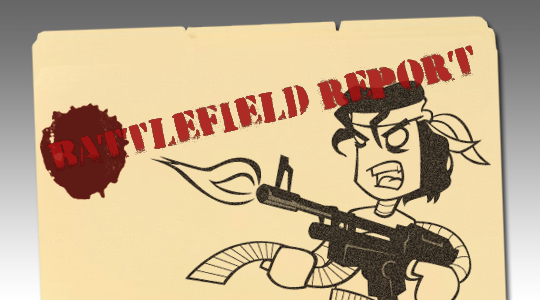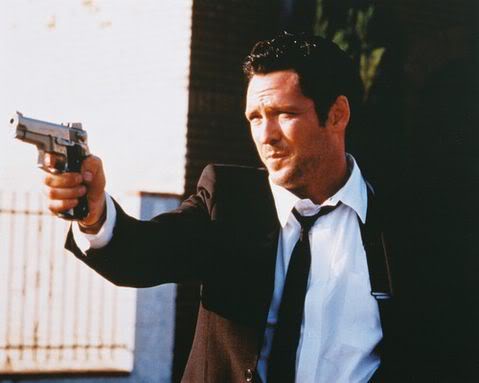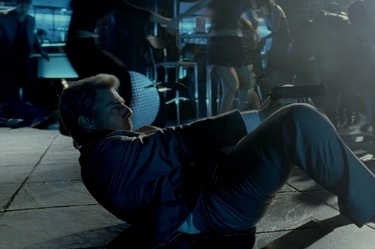

Traditionally, games have portrayed military and special ops characters as being unrealistically proficient. Part of the reason for this is to distance video games from reality while still drawing in players by emulating logical assumptions based on real occurrences - if it makes sense that Aerosol + Bullet = Xplosion, then the entertainment industry will embrace that.
Shooting stances are a major part of these perceived violent scenarios. If the hero looks like a pro holding a gun...well, we've already taken that turn back there at Logic Street. Splinter Cell: Conviction took this concept a little farther and tried to incorporate something more real and unique than any other game has show so far: the C.A.R. (Center Axis Relock) stance. Did it succeed in impressing an action game fan and sport shooter? Let’s explore.
First, a little bit of history...
Michael Madsen as Mr. Blonde demonstrates 'point shooting' in Reservoir Dogs
Classically, the U.S. Army and allied nations taught a method of self-defense called “point shooting”, which is almost as simple as shooting gets. The shooter can either fire from the hip, or stretch their shooting hand out at the target as best they can while hammering away at the trigger. It’s a bit frantic and really only effective in really close quarters. Since the aiming vector of a short-barreled firearm changes drastically with only a little bit of wrist movement, point shooting was taught as a last resort...and still is, in fact.
Tom Cruise as Vincent demonstrates the 'isosceles stance' while on his back in Collateral
A little more stable is the “isosceles stance”, or as the overcompensating elitists like myself call it: the Lady Grip. It consists of holding the pistol out in front and locking your elbows - literally an isosceles triangle when viewed from overhead. This stance will ensure a good aiming platform...but in a combat situation it lacks freedom of movement.
Jeffrey Donovan as Michael Westen demonstrates the 'Weaver stance' in Burn Notice
In 1959, however, a competitive pistol shooter named Jack Weaver developed what became known as simply the “Weaver stance”. This two-handed style of aiming - in which the strong arm is extended as far as possible, while the weak arm provides support and backward tension - departed from wild-west speed drawing and focused more on getting bullets to the target more precisely. It also helped with recoil management, which was an issue among carriers of semi-automatic pistols (.45 caliber being the most common, which has a real bear kick compared to .38 caliber service revolvers). Weaver style is very popular now, especially among those trained with firearms. So familiar is it with film fans, gamers, and shooters alike that it has spawned a one-handed style and other variations with keep the aiming arm extended and bent.
Splinter Cell: Conviction's box art features Sam using a Weaver grip without the supporting weak arm
And in 2009, a former British police officer by the name of Paul Castle publicized what he called the “Center Axis Relock” stance. Looking for something fresh and exciting, Ubisoft picked up the concept and incorporated it into this year’s Splinter Cell game. It involves the same concept of isometric tension as the Weaver stance...except that in using C.A.R. you hold the pistol at the center of your body width and grip it by compressing your hands toward each other. The result is an extremely tight grip that can handle even the most stout recoil; unfortunately, every example of C.A.R. shooting that I’ve seen on video results in a great shot grouping...from about six feet away. Granted, this stance is used for close quarters combat only, but when I see it employed in a game like Splinter Cell: Conviction, my first assumption is that the technique is more versatile than just shooting a stationary target in the same small room.
Sam Fisher demonstrates Center Axis Relock
Sadly, all indications point to, “nope, that’s it”. According to Paul Castle it is possible to gain so much experience with C.A.R. that someone could actually perform the feats that Sam Fisher does in Conviction. Myself, I highly doubt that. If Castle himself needs to stand six feet from his paper target in order to provide such good shot placement, then how can anyone else be expected to...especially when there are so many more natural ways to handle the pistol?
Weaver - still the best, in this writer's opinion
While doing some research for this article, I came across a video - made in 1996 - that was part of a comprehensive behind-the-scenes look at the movie The Rock. In it, a former Navy SEAL and technical consultant described one of the biggest no-no’s in handling a firearm, and that was the “belt draw”: drawing a handgun from behind the back and letting the muzzle cross the waist. While C.A.R. isn’t necessarily so negligent, it does place the shooter’s weak side elbow and chest area in an unsafe position with regard to the pistol’s muzzle. Just another reason why little-old-me wasn’t very impressed.
So basically all of this has led up to one simple statement: I don’t care much for Center Axis Relock in a real-world application. As cool as the name sounds, the combat method itself is no more effective than a simple case of common sense, in my opinion. But as long as bigger-than-life video game characters are using things like the C.A.R. stance in situations that are believable within the context of the game, even sticklers like myself can let it slide. It just serves as yet one more reminder that games are not simulators...and that I am a complete nerd.